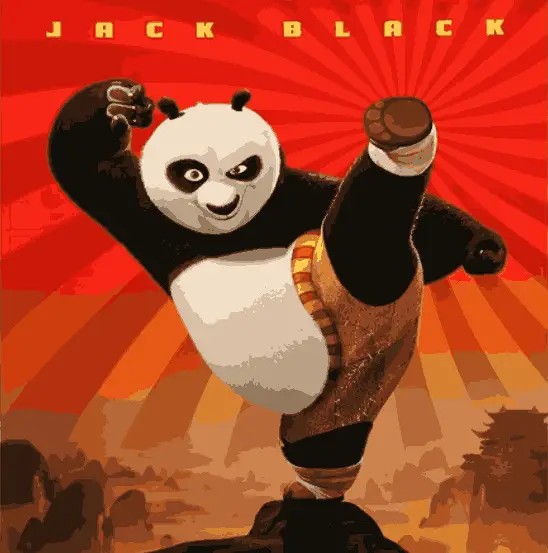kung fu panda success story: when Kung Fu Panda was released in China, it sparked a national debate about why a Hollywood studio was able to make a better movie about Chinese culture than Chinese studios are able to make about their own culture Kung Fu Panda made $58 million on its opening weekend in China, making it the biggest opening weekend for an animated movie in China but DreamWorks worked hard to ensure this would happen They consulted Chinese Cultural experts when writing the movie and reanimated the whole movie in Mandarin to ensure the mouths match the words in the Chinese version This left many people asking,

source: Dreamwork pictures
Why can’t we do this? some people pointed at the Chinese education system, saying students are only taught how to pass exams and Imagination and creativity are actively suppressed Others pointed at budgets, saying Chinese Studios have nowhere near the same amount of money to make movies While others pointed at censorship, film director L Tron said every character in Chinese animated movies needs to be perfect and this is very different than po who is lazy eats too much and has a tendency to run from danger Po even talks back to his Kung Fu teacher, something that could never happen in a Chinese movie.
Kung fu panda success Stroy detailed description:
Upon its release, “Kung Fu Panda” immediately captivated Chinese audiences, amassing an impressive $58 million during its opening weekend. This monumental achievement set a new benchmark for animated films in China, establishing the movie as not just a commercial success, but a cultural phenomenon. The widespread acclaim can be primarily attributed to DreamWorks Animation’s meticulous efforts to infuse the film with authentic Chinese cultural elements.
In preparation for “Kung Fu Panda,” DreamWorks consulted extensively with Chinese cultural experts. This collaboration aimed at ensuring a respectful and accurate portrayal of Chinese traditions and philosophies. Additionally, DreamWorks undertook the painstaking task of reanimating the film to align the characters’ mouth movements with the Mandarin audio track. Such attention to detail emphasized the studio’s commitment to providing an authentic experience for the Chinese audience.
The storyline of “Kung Fu Panda” intertwines classical Chinese folklore, martial arts, and philosophical themes, reflecting the richness of Chinese cultural heritage. Characters like Po, the protagonist, embody attributes prevalent in Chinese narratives, such as resilience and a quest for self-improvement. The reverence for kung fu, a pivotal element of the film, is depicted not merely as a fighting skill but as an art form rooted in spiritual and philosophical foundations.
also read : 9-things-women-notice-in-mens
This dedication to cultural authenticity resonated deeply with Chinese viewers, who recognized and appreciated the thoughtful representation of their culture. The film’s success goes beyond mere box office numbers; it sparked conversations around the global recognition and embrace of Chinese culture. The intriguing blend of Western animation expertise and Chinese cultural elements created a unique cinematic experience, contributing significantly to the movie’s overwhelming popularity in China.
Thus, the unprecedented success of “Kung Fu Panda” is a testament to DreamWorks Animation’s strategic and respectful approach to cultural representation. By seamlessly integrating quintessential aspects of Chinese culture, the film not only entertained but also fostered a positive and reflective engagement with its audience. The resulting cultural exchange highlighted the potential of global cooperation in the realm of cinematic storytelling.
Hollywood vs. Chinese Studios
The remarkable success of “Kung Fu Panda” has spurred an engaging cultural debate within China, shining a spotlight on the country’s local film industry. Many found it curious, if not troubling, that a Hollywood studio could create a film so deeply rooted in Chinese traditions and culture, raising questions about the capabilities and approaches of domestic filmmakers.
At the heart of the critique is the authenticity of cultural representation. “Kung Fu Panda” adeptly harmonized elements of Chinese culture—ranging from kung fu martial arts to philosophical teachings—within its narrative and aesthetic design. This accomplishment prompted a slew of critical reflections and discussions amongst both audiences and pundits in China. They began examining why indigenous studios had yet to produce a similarly impactful work that resonated so engagingly with national cultural themes.
Storytelling techniques formed another pillar of the debate. Hollywood’s penchant for blending exhilarating narratives with rich, character-driven tales was evident in “Kung Fu Panda.” This approach arguably outstripped much of the local content produced in China at the time. Critics pointed out how Hollywood’s sophisticated narrative structures, character development, and emotional arcs allowed it to transcend cultural boundaries, making the film appealing not only within China but globally.
Moreover, production values were under significant scrutiny. The meticulous attention to detail, high-quality animation, and seamless integration of traditional Chinese elements demonstrated Hollywood’s superior technological capabilities and artistic involvement. The stunning visuals and coherent use of culturally significant motifs showcased DreamWorks’ dedication to authentic and respectful representation of Chinese culture, something local studios were criticized for lacking.
This national reflection triggered by “Kung Fu Panda” led to a more profound contemplation of the Chinese film industry’s future direction. There were calls for a re-evaluation of local filmmaking strategies, with an emphasis on expanding production competencies, improving storytelling techniques, and ensuring authentic cultural representation. As a result, the dissection of “Kung Fu Panda” served as a catalyzing agent for introspection, ultimately pushing Chinese studios to strive for not just commercial success, but also cultural validity.
The Chinese education system has been frequently cited as a significant factor contributing to the disparity in the ability of Chinese studios to create culturally resonant films. Critics argue that the system’s intense focus on rote learning and exam performance could stifle creativity and imagination. This emphasis on memorization and test scores is thought to limit the opportunity for students to develop storytelling skills and innovative thinking, which are essential for the creation of engaging and relatable films.
Budget constraints are another critical factor affecting the Chinese film industry’s capacity to rival Hollywood in producing high-quality animations. Hollywood studios, backed by substantial financial resources, can afford to invest heavily in state-of-the-art technology, top-tier talent, and extensive marketing campaigns. In contrast, Chinese studios often operate with smaller budgets, which can restrict their ability to produce animations that match the technical and narrative quality found in Hollywood productions.
Censorship within the Chinese film industry has also been pinpointed as a major hurdle. The stringent regulations governing film content in China require that characters be morally perfect, which greatly limits the complexity and depth that can be attributed to them. This restriction contrasts sharply with Hollywood’s approach, where characters like Po from “Kung Fu Panda” are crafted with imperfections and significant growth arcs, making them more relatable and engaging to a broader audience. Such censorship regulations hinder Chinese filmmakers from exploring and presenting nuanced characters and stories, thereby constraining creativity and relatability in their films.
In essence, the disparities in education systems, budget allocations, and freedom of creative expression collectively contribute to the challenges faced by Chinese studios in producing culturally impactful films. Addressing these issues may require systemic changes and investments to foster an environment that nurtures creativity, supports robust production capabilities, and allows for more complex and relatable storytelling.
The Role of Characters and Narratives in Film Success
One crucial factor in Kung Fu Panda’s success was its character development. The protagonist, Po, is portrayed as a relatable character with flaws—he’s lazy, food-loving, and sometimes cowardly. This relatability stems from the universal truth that everyone has imperfections, making Po’s journey more engaging and authentic to audiences worldwide. As viewers watch him struggle and fail, they connect with his vulnerabilities, rooting for his eventual triumph.
His evolution throughout the film, including his moments of defiance against his kung fu teacher, added a depth often missing in Chinese animated films. In Western cinema, characters like Po are allowed to be multidimensional; they grow, change, and learn from their mistakes. This approach contrasts starkly with the rigidity often found in Chinese cinema, where characters are generally depicted as paragons of virtue. These idealized portrayals, although inspirational, can sometimes appear one-dimensional and disconnected from real-life experiences.
Film director L. Tron noted that such character flaws would never be permitted in Chinese cinema. This observation sheds light on the broader cultural preferences and production constraints within Chinese filmmaking. Hollywood’s flexibility in narrative structures and character development allows for more creative liberties. This creative freedom is not just a luxury but a vital component that has contributed significantly to Kung Fu Panda’s broad appeal and success.
The film has sparked further debate on the importance of narrative freedom in creative storytelling. It underscores the idea that characters, like people, are more compelling when they are allowed to be imperfect. This flexibility to portray nuanced, evolving individuals resonates deeply with audiences, breaking cultural barriers and creating universally beloved films. The success of Kung Fu Panda inevitably invites reflection on how narrative and character development practices influence the reception of animated films globally.
this is how kung fu panda success happend.
Frequently Asked Questions:
- Who is the main character in Kung Fu Panda?
- The main character is Po, a Panda who becomes the Dragon Warrior.
- Who voices the character of Po?
- Jack Black voices Po.
- What is the name of Po’s adoptive father?
- Po’s adoptive father is Mr. Ping, a goose who runs a noodle shop.
- Who are the members of the Furious Five?
- The Furious Five consists of Tigress, Monkey, Mantis, Viper, and Crane.
- What is the Dragon Scroll?
- The Dragon Scroll is a powerful artifact that is believed to grant unlimited power to its holder.
- Who is the main antagonist in Kung Fu Panda 2?
- The main antagonist in Kung Fu Panda 2 is Lord Shen, a peacock.
- What is the name of the village where Po was born?
- Po was born in the Panda Village.
- Who trains Po to become the Dragon Warrior?
- Master Shifu, a red panda, trains Po.
- What styles of Kung Fu do the characters use?
- Each character uses a different style of Kung Fu: Tigress uses Tiger Claw, Crane uses Fujian White Crane, Monkey uses Monkey Kung Fu, Viper uses Snake Kung Fu, and Mantis uses Northern Praying Mantis1.
- Is there going to be a Kung Fu Panda 4?
- Yes, there are plans for a Kung Fu Panda 4









